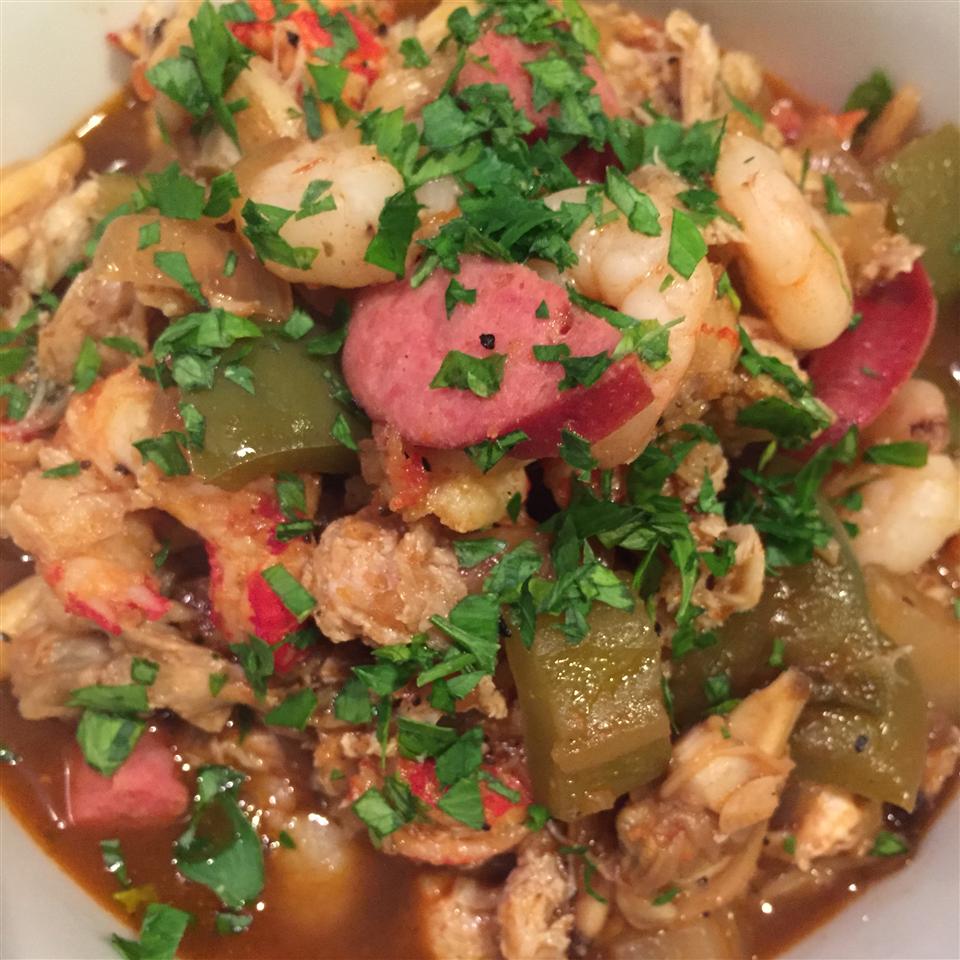Seafood File Gumbo

This is a big recipe and a big time-consumer, but delicious! Serve gumbo over 1/3 cup cooked rice per serving in bowls.
INGRIDIENT
DIRECTION
Step: 1
Preheat oven to 375 degrees F (190 degrees C).
Step: 2
Shell and devein the shrimp, reserve the shells. Place the shrimp in a covered bowl and refrigerate. Place the shells on a cookie sheet, and bake until the shells are dried and starting to brown on the edges. Turn off the oven.
Step: 3
Make the stock: In a 8 quart pot, put 5 quarts of water, 4 carrots, 4 onions, and celery. Add 2 bay leaves, sliced garlic, parsley, cloves, 1 teaspoons black pepper, 1 tablespoon dried basil and 2 teaspoons dried thyme. Add the shrimp shells. Bring the stock slowly to boil. Reduce heat to a gentle simmer and cook 5 to 7 hours, replacing water as needed, 2 or 3 times, by pouring more water down side of pot.
Step: 4
Remove stock from heat and strain. Press all liquid from the shells and vegetables, then discard them. Return liquid to heat and reduce stock to 2 to 3 quarts, or to your desired quantity (you will need 7 cups of this stock for this recipe). If clarity is desired, strain the stock through a cloth.
Step: 5
In a small bowl, combine the ground red, white, and black peppers, paprika, thyme, oregano, bay leaf and salt and set aside.
Step: 6
In a heavy pot, 5-quart or larger, heat oil over medium heat, warming the pot first. Add onions, celery and green pepper. Turn heat to high. Stirring frequently, add garlic, file, hot pepper sauce, and the pepper-herb mixture. Cook for 5 minutes, stirring constantly. Add tomato sauce and stir as it reduces over high heat. Add 7 cups of the stock and bring to a boil. Reduce heat and simmer for 1 hour, stirring occasionally.
Step: 7
When ready to serve, add shrimp, oysters, and crabmeat. Cover and wait 5 minutes. Turn off heat and let stand for 10 minutes.
NUTRITION FACT
Per Serving: 418 calories; protein 28.8g; carbohydrates 24g; fat 23.6g; cholesterol 142.3mg; sodium 950.8mg.
The word “stew” can refer to 2 time a food and a cooking method. Stewing involves slowly cooking chunks of meat, raw fruit or beans in a flavorful liquid . It’s same as to braising, instead it makes have a few notable differences. The raw animal vested is chopped into few of pieces instead of being processing menu all of it , and the water based material completely covers the contents in a stew as different to a braise’s halfway all of it . When meat or raw fruit are cooked using this method, the resulting dish is called stew.
Stew has a reputation for being a rib-sticking meal that comfortable you up on a cold , winter day. It’s true ; a bowl of classic beef stew can make warming featured food , but stew’s cozy factor goes way beyond protecting you from the cold . It’s all about those tender chunks of food and vegetables, swimming in a thick, ultra-rich gravy. The way they come together creates the ultimate comfort food, no matter the weather.





